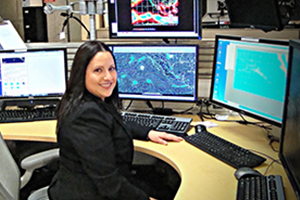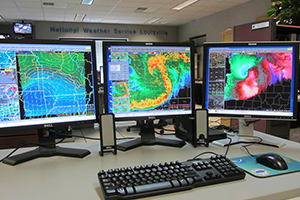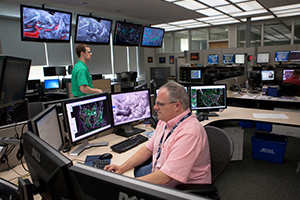If it falls from the sky, flows across the surface of the Earth, or is released from the Sun, the National Weather Service most likely produces a forecast for it. NWS meteorologists across the country create forecasts for a wide variety of weather elements such as rainfall, snow storms, severe weather and hurricanes. Our hydrologists specialize in how water flows across the landscape and makes it into lakes, streams and rivers. While additional meteorologists and oceanographers produce wave forecasts for our Nation’s oceans and the Great Lakes. Climate forecasters in the NWS focus on large-scale temperature and precipitation patterns and time scales ranging from a couple weeks to several months.
The forecast process is roughly the same regardless of the type of weather. Our scientists thoroughly review current observations using technology such as radar, satellite and data from an assortment of ground-based and airborne instruments to get a complete picture of current conditions. Forecasters often rely on computer programs to create what’s called an “analysis,” which is simply a graphical representation of current conditions. Once this assessment is complete and the analysis is created, forecasters use a wide variety of numerical models, statistical and conceptual models, and years of local experience to determine how the current conditions will change with time. Numerical modeling is fully ingrained in the forecast process, and our forecasters review the output of these models daily. Often, the models yield different results, and in these circumstances, forecasters will determine which models perform best for the given situation or seek a blended solution.
One of the key considerations associated with any forecast is the element of uncertainty. The chaotic nature of the earth-atmosphere system and incomplete sampling of its complicated physical processes mean that forecasts become more uncertain at longer time ranges. This uncertainty is why the human component remains a vital piece in the forecast process; as once the forecast is complete, effectively communicating the forecast message becomes as important as the details of the forecast itself. This includes communicating which parts of the forecast are “uncertain” or what might be the “worst-case scenario” if the forecast changes. In addition to using the latest science and technology, NWS staff work with their partners to understand the impacts weather and water events have on our local communities. Now more than ever, NWS staff across the Nation are working hand-in-hand with public safety officials providing forecast advice and interpretation to help them make decisions when weather, water and climate impacts the lives and livelihoods of the American people.
 |
 |
 |
| Forecasting desk in a WFO. | WFO computers use the AWIPS forecasting system. | The Storm Prediction Center is located in The National Weather Center in Norman, OK. |